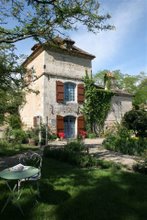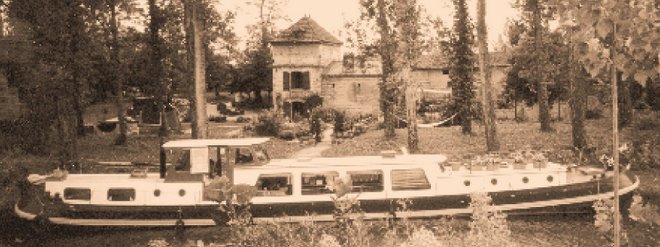Cassoulet- this is part of a French Kitchen primer from my winter classes. Since I'm taking this step by step, and lightly- don't go getting too obsessive on me now; let me tell my cassoulet recipe in my own way. Like a good student- listen, look and then try it- your own way. Centuries of French housewives have made cassoulet without a written down recipe. But they did have three advantages over you- eyes in France, ears in France and best of all-- a tongue in France!
I learned to make cassoulet here in Southwest France that same way. I arrived one cold spring along the Canal du Midi on my barge, the Julia Hoyt. It was 1988. I was 37. Taking respite from strong Midi winds called the Tramontana, my mates and I bumped into the sheltered back port at Castelnaudary to moor up for a few days, weeks, whatever. We stayed some months.
This was my first taste of a truly regional dish. Here, on every shop sign, butcher shop, traiteur, and dedicated-to-the-bean "Cassouletier" was the same iconic emblem- a flared open terracotta pot with a double lip and small pouring spout- it's called a cassole. And this IS the home of Cassoulet. Before someone interrupts to tell me that Toulouse and Carcassonne like to compete for the 'best' cassoulet in the Southwest, tell me just where is the town with a water tower painted like a giant cassole? Yup, Castel-nau-dary.
It's actually very difficult to make cassoulet in Castelnaudary since half of the town does it for a living. Why go through all the bother when their are beautiful small shops, busy wood fired oven cafes and industrial kitchen factories dedicated to perfecting the recipe? One can stop in and order a 10-person, a 6-person or even a very generous 2 person cassoulet complete with perfect crusty top for a few centimes, francs, euros, or whatever is current. After paying a deposit on the take-out bowl, I'd cradle the full cassole on the back of my bike and returned to the Barge galley-- reheat in a slow oven, serve with a green salad and pour a bottle of big red wine from the Minervois. Eh Voila! A real authentic Cassoulet!
But as I left the the Grande Bassine along Pierre-Paul Riquet's curvaceous Canal du Midi, and was beginning to have C-withdrawals, I ran smack into the 'egg' of this recipe perched on the towpath by l'ecluse de la Mediterranean- at the vine-covered lock next to the Poterie Not Freres.
Since that long ago day, I have bought more than my fair share of hand thrown pots, water jugs, umbrella stands and garden urns from Aime, his Brother and Nephews. I have photographed, filmed, talked and coerced with a bottle of armagnac until I learned a few secrets, had a big picture and counted them as friends. But most important of all, that day, I came away with a simple cassole that would inspire my cassoulet endeavors for a couple decades- a thick-walled, hand-thrown clay pot with sturdy lip and pouring spout that could sit in an oven for hours and cradle the beans as they plump in their own juices.
People ask all the time "how to make a Cassoulet" but it wasn't until I headed to Italy this summer to do a little wood-oven cooking with La Diva that I had that 'Ta-Da' moment. The one where the slow burn of 19 years of cooking a simple peasant bean dish in the same pot finally transforms into a gastronomic surety. Time. Time, my friends, remains the too secret and often missing ingredient in a great cassoulet. Not just the 19 years of learning but time enough to slip a properly-made cassoulet in the oven overnight for tomorrow's lunch. Time to think about buying some nice fatty sausages (thanks Dario!) while shopping; time to soak the Tarbais beans I bought at the market in Agen and tucked in my suitcase; time to wait a whole week to cook la piece de la resistance. Then I finally placed the French pot on the spent ashes in the wood oven that had cooked and baked and grilled for an entire week. It was just enough time to turn the melting beans into a self-crunching crust- no breadcrumbs allowed.
Just like this story, you can't rush a good bean. Slow and easy. Now, for a more leisurely look at that clay dusted workshop on the Canal du Midi way back then... click on www.longvillage.com
 Next... the beans.
Next... the beans.











5 comments:
This is very inspiring, Kate. Thank you!
Kate, I come to your site thru Lucy's. I was reading about her cassoulet and hopped on the link over to your site. As I was reading your post, I noticed the paragraph where you are talking about where you learned to make cassoulet. Mention of the Julia Hoyt and the Canal due Midi rang a bell. I popped out of my chair, went to my bookcase and picked up a book I have treasured "A Culinary Journey in Gascony" by Kate Ratliffe! This has to be you! I purchased this book back in 1995 and have a special place on my "Books about France" section of my cookbook shelves. I always thought it would be so cool to travel in France on a barge like you did. I was lucky to be able to visit France back in the mid 90's but was only in the northern part of your country, Saumur to be specific.
Well, I will stop my chatting for now, but I cannot tell you how excited I am to discover your site and I will be stopping by each day. I guess the saying "it is a small world" can be correct!
Cheers!
Your pictures of French kitchem implements are wonderful to look at.
Carolyn
18thC Cuisine
Thanks Lucy for such wonderful energy.
Deb- indeed these small worlds spin in ever decreasing orbits of good foods and new friends. Maybe it's time to come to France again!
And dear 18th-C Carolyn- I have long been a secret friend. Thanks for visiting! Wouldn't it be nice if we could have tea together?
I am SO GLAD I found your site. This is wonderful. I'm off to read more.....
Post a Comment